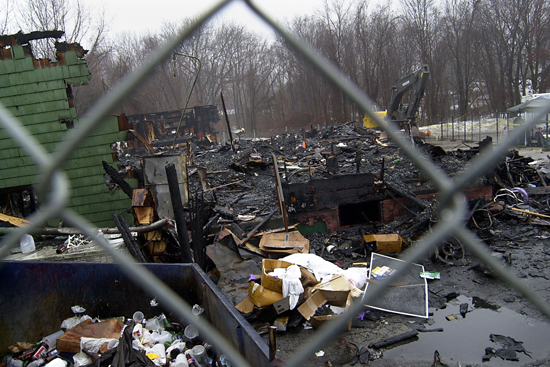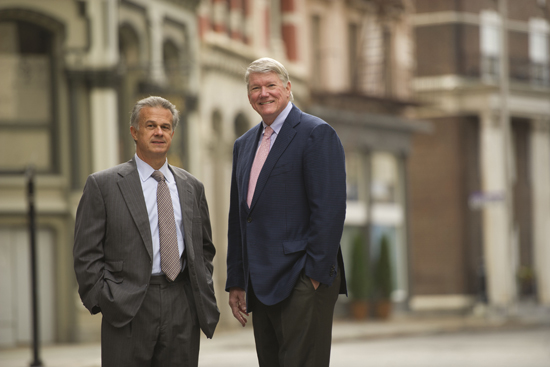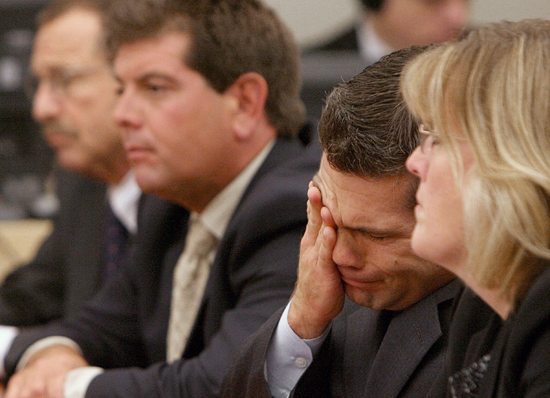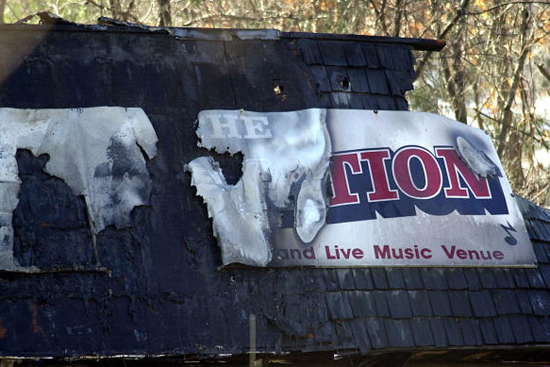Hell, 10 Years Later
Two alums approach the Station nightclub fire from different sides

A winter rain falls on ashes from the Station fire, where 100 people died and 230 were injured. Photo by Douglas McFadd/Getty Images
John Barylick wasn’t surprised when his phone started ringing early on the frigid morning of February 21, 2003. Like many in a small state where news travels fast, the Providence-based lawyer had already heard about the previous night’s fire at the Station nightclub in West Warwick, R.I.—he knew about the pyrotechnics gone terribly wrong, the flaming wall of soundproofing, and the deadly stampede for the exit.
Barylick (LAW’77), a partner in the personal injury firm Wistow, Barylick, Sheehan & Loveley, had heard about the scores of dead and injured in what would prove to be one of the deadliest club fires in U.S. history.
In Dallas, Tex., around the same time that Barylick got his first call from a potential plaintiff, Charles “Chip” Babcock (LAW’76) was contacted by the general counsel for LIN Television Corporation, which owned 50 TV stations around the country. The counsel told Babcock, a partner in Jackson Walker, about two potentially costly connections that linked LIN to the deadly blaze. First, the club was owned in part by Jeffrey Derderian, a recently hired reporter for the LIN-owned, Providence-based television station WPRI. And second, WPRI cameraman Brian Butler was filming inside the club at the time of the fire. There was one more thing: Butler’s taping was Derderian’s idea. In a tragic paradox, the club owner had decided to make a video about nightclub safety after learning of the February 17 stampede that caused the deaths of 21 patrons of the Chicago nightclub E2. When the last embers cooled, the death toll from the Station fire would dwarf the Chicago disaster: 100 people were dead and 230 injured. Only one-third of the crowd, 132 people, escaped unharmed.
A decade later, the fire has brought tough new code provisions for sprinklers and crowd management in nightclub-type venues in Rhode Island and other states. Its aftermath reflects a legal system that strives, sometimes in strange ways, to compensate people for profound losses. How it works, and why it works the way it does, is described in Killer Show: The Station Nightclub Fire, America’s Deadliest Rock Concert (University Press of New England, 2012), written by Barylick. Its title comes from a boast by heavy metal band Great White lead singer Jack Russell on that fateful night.

The video made by Butler has been viewed hundreds of thousands of times on YouTube. It begins with excited gestures from the crowd, the arrival on stage of Great White, and the ragged flair of the first burning fleck of metal igniting the soundproofing foam as the band hits its first, and last, notes. “Oh, that’s not good,” Russell, who survived the fire, is heard to say as the time clock reads 11:00 p.m. Then comes an increasingly panicked scramble to get out of the building. By 11:06, many had not. They succumbed to the combined effects of 1,000-degree heat, falling debris, and carbon monoxide and hydrogen cyanide from a lethal burning sandwich of polyethylene and polyurethane foam. Others suffocated in a pyramid of bodies by the front door.
In the version used as evidence, the tape, which continued to record in the Station parking lot as first responders arrived, is synched with sound from a working audiocassette found on the body of a victim who perished in the flames. Although he’s watched the video many hundreds of times and has analyzed it frame by frame, Barylick winces as he replays it on his laptop to illustrate a still-disputed point: had Butler, once safely outside and continuing to tape—he phoned his station to say he had some great footage—blocked the door for critical seconds? Or had he, as Babcock maintains, been assisting others as they surged toward the exit, guided by the light of his camera?
Station owners Michael Derderian and Jeffrey Derderian would eventually plead no contest to 100 counts of involuntary manslaughter. Great White tour manager Daniel Biechele, who set off the pyrotechnic plume that triggered the deadly inferno, would plead guilty to involuntary manslaughter. (Biechele was paroled after serving 16 months of a 4-year sentence; Michael Derderian served 27 months of a 4-year sentence; and Jeffrey Derderian avoided jail time with a sentence of 500 hours of community service.) Rhode Island Superior Court Judge Francis J. Darigan said he accepted the pleas “to avoid further traumatizing not only the loved ones of the deceased and the survivors…but the general public as well.” Although the Derderians offered tearful apologies, the plea agreements added insult to injury for some of the families, who left the courthouse convinced that the brothers had gotten away with something akin to mass murder. Enraged, they sank their hopes into the massive civil action under way by Barylick, whose firm was co–lead counsel of a team of attorneys sparing no expense to establish responsibility on the part of people and corporations.
Barylick and Babcock, both School of Law graduates, found themselves on opposite sides of a legal action that would consume much of the next seven years. As grand jury testimony would reveal, the Station, with its history of citations for fire hazards, was an atrocity waiting to happen. Lacking sprinklers and with exits that violated fire codes, the club packed in nearly 100 more people than its legal occupancy allowed for the oversold Great White concert—and even the legal number was based on a bogus standing-room formula.
Combing through evidence, Barylick was reminded time and again how the smallest changes in architecture and procedure could have saved lives. Many attempting to flee were turned away from the stage door, which not only opened in, a violation of the fire code, but according to grand jury testimony, was guarded by overzealous bouncers even as the club was engulfed in flames.
As is often the case in catastrophic events, those who were most directly responsible for the fire lacked the resources to pay the nearly 300 plaintiffs. The band and the club owners had only $2 million in insurance coverage between them. Barylick and other attorneys for the plaintiffs pursued others, who were more removed from the events of the night, but were closer to the kind of money that a court would be likely to award.
“At first blush it’s completely daunting, and humbling,” says Barylick, in his soft-spoken but exacting manner. “There is something a little unseemly about trying to attach a dollar value to lives of the dead and injured. In fact, if anyone had their choice, they would turn back the clock and undo what’s been done, but with that impossible, we use the civil justice system to try to make people as whole as possible.”
In the video above, watch episode one of new online documentary series The Station by filmmaker David Bettencourt (COM’01). Bettencourt will post six episodes over the next six weeks, and he hopes to release a second series about the fire next year.
Visceral sense of worry and shock
Babcock and Barylick have known each other since they were classmates at Brown University, both graduating in 1971. Each would find his way to the law, but they had very different interests. Barylick was a theater person, and Babcock favored athletics, first basketball and then crew. Barylick, who grew up in New Jersey, worked for IBM for three years before enrolling in LAW, while Brooklyn, N.Y., native Babcock’s first job was as a sportswriter for the Philadelphia Inquirer. Built like a linebacker, with a curtain of white hair, Babcock continues to unwind on the basketball court and is a regular at Red Sox spring training and playoff games. And avid snowboarder Barylick, who hits the slopes whenever he gets the chance, still occasionally graces a stage, singing with a group that reenacts 1940s radio shows.
On the night of the fire, each man experienced a visceral sense of worry along with shock, and reached for phones. Both had daughters—Babcock two and Barylick one—who were students at Brown that year. And although none was a heavy metal fan, as Barylick puts it, “You just never know.” As it turned out, his daughter was an EMT at the time, and knew many of the first responders.
Barylick’s firm was one of eight that pooled money and manpower to comb through more than 700 pieces of evidence and survivor testimony to decide whom to target in the civil suit. “Probably the two most important pieces of evidence were the video shot inside the club that night, and the type of foam found to have been applied to the walls of the drummer’s alcove in 1996,” Barylick says. “The first provided a real-time record of the intensity and speed of the fire, and the second allowed the plaintiffs to identify a key contributor to the fire’s lethality.”
Filing complaints in stages, with the final amended list filed three years after the fire, just under the wire of the soon-to-expire statute of limitations, the plaintiffs’ attorneys named nearly 100 defendants, a list that was eventually winnowed, after the courts’ dismissals, to 88, including LIN, which Babcock had been hired to defend. His clients were not criminally charged, but were defendants in a civil suit charging them with wrongful death or personal injury. Babcock was among 60 defense attorneys who worked the case. “Their cumulative billing rate,” writes Barylick of an initial court conference of all parties, “was about $200. Per minute.”
While Babcock fended off assaults on LIN, the battery of defense attorneys set to work constructing legal bulwarks around the manufacturers and distributors of the flammable foam; Anheuser-Busch, which held a Budweiser promotion at the Station that night; and the company Clear Channel, which paid the emcee passing out Budweiser T-shirts and hats.

One of Babcock’s main concerns was that if Jeffrey Derderian were sued as an agent of the TV station as well as being a bar owner, the reputation of WPRI would suffer. So he filed, and won, a motion to dismiss the claim against Derderian in his capacity as a TV station employee. Babcock’s main strategy was to limit discovery from his clients by moving for a summary judgment—a decision based on existing evidence.
Babcock’s only misgivings after the case concluded concern Butler, who is still employed as a WPRI cameraman.
“I had eyewitnesses who refuted the plaintiffs’ allegations against Butler,” Babcock says, referring to claims that Butler had obstructed the exit. “These people were with Brian all the way and testified he never stopped to film. The reason he got the video was because the camera was rolling and he had it on his shoulder, pointed back toward the fire. One person who’d been trapped inside told us that he found a window to escape through only because he heard Brian from the outside saying, ‘Is there anybody in there?’ and shining his light.”
Hitting a wall
In 2006, after filing a consolidated wrongful death case and assembling a staggering lineup of expert testimony, Barylick and the other plaintiffs’ lawyers hit a wall in the form of a surprising state law. Barylick says the unusual statute would have allowed an agreed-upon settlement by the remaining defendants to be drastically slashed if a subsequent jury trial found that the first defendant to settle was, say, 90 percent at fault. The rest of the judgments—in this case tens of millions of dollars—would be reduced by 90 percent of their total value.
So Barylick and his team went after the law. They petitioned the Rhode Island House and Senate judiciary committees and persuaded the legislature to bring the state into line with most others and provide for a straight dollar-for-dollar setoff when one of many defendants settles.
“That,” recalls Babcock, “was very clever.”
By summer 2008, after nearly five years of wrangling, settlements that totaled $176,193,718 were struck in principle with almost all of the defendants. Francis E. McGovern, a Duke University law professor, was brought in by the court to figure out how to divide the money, solving “one of the knottiest problems arising from the Station tragedy,” as Barylick puts it. “Professor McGovern’s distribution plan was to strike a fair balance.”
During two months of meetings with Station victims and their families, McGovern, charged with a task worthy of Solomon, visited the fire site each morning. After much open discussion, the families agreed on a point system that would distribute the funds both fairly and efficiently, says Barylick. McGovern devised a system specifying a base point value for every death, which was increased depending on the victim’s age and whether there were children or a spouse. For the injury cases, the points were based on each dollar of medical expense, a legal shorthand that ultimately correlated well with factors not so easily measured, like degree of scarring and suffering.

“Apparent inequities abound in the law—and would have to be accepted by all plaintiffs,” Barylick writes in Killer Show. There are many glitches in the law, but “perhaps most difficult for families to accept” was that generally Rhode Island law doesn’t compensate families for their grief—rather, “it is a purely economic calculation, intended to replace the decedent’s lost net earnings and services to his dependents.”
The money, which finally found its way to the plaintiffs in 2010, came from 28 of the defendants, who agreed to part with amounts ranging from $1,000 to the $30 million paid by Babcock’s deep-pocketed client LIN—the amount negotiated and agreed upon by LIN’s insurance companies. Other defendants who paid up include the town of West Warwick ($10 million), the state of Rhode Island ($10 million), Great White’s Jack Russell ($1 million), Anheuser-Busch ($5 million), Clear Channel Broadcasting, Inc. ($22 million), American Foam Corp. ($6.3 million), Sealed Air Corporation ($25 million), General Foam ($11.2 million), and Home Depot and insulation company Polar Industries, Inc. ($5 million), along with a range of insurance companies.
Like most plaintiffs’ trial lawyers, Barylick had worked on a contingency fee, with his firm’s payment deducted from his clients’ shares of the final settlement. In total, the plaintiffs’ lawyers eventually shared nearly $58 million. (Their out-of-pocket expenses during seven years of representation amounted to about $2 million.)
Babcock, of course, would have welcomed the chance to argue his clients’ case before a jury.
“He’s a trial lawyer,” says Barylick. “He lives for that.” Despite his “mixed emotions about the settlement,” Babcock says, “John and the other lawyers were brilliant in how they brought about the conclusion of the case,” which, he says, “was good for the state of Rhode Island and closed this sad chapter.”
And in spite of an outcome generally favoring the plaintiffs, the case had personal rewards for Babcock. He was able to be in Providence, close to his daughters, and “the Rhode Island attorneys treated me very well, even though I was a foreigner.” Also, after overlapping paths for years, says Babcock, “finally getting to work a case with John was a great experience.”
By the 10th anniversary of the fire, in February 2013, the legal battles will have been lost and won, but the legacy of the Station fire endures. In September of last year, the owner of the tragedy site donated the land to the Station Fire Memorial Foundation, which will build a permanent memorial where there are now heartbreaking personal remembrances. A cross is adorned with family photographs of Kelly Vieira, 40, a physical therapy assistant and mother of two, whose husband, Scott, who survived, was enlisted as a bouncer for the Great White concert. A memorial to Great White member Ty Longley, who died in the fire, is detailed with frets like the neck of a guitar. There is a shrine for Fred Crisostomi, a painter who decided at the last minute to check out the concert, bringing his girlfriend, Gina Russo, a medical secretary and mother of two. As they pushed toward an exit under what she later described as a “black rain” of burning plastic and smoke, Russo said a prayer for her two sons and passed out, waking in a Boston hospital 11 weeks later from a medically induced coma, with major burns to her body and lungs.
One of the beneficiaries of the lawsuit was Linda Fisher of Cranston, who suffered life-threatening burns over 30 percent of her body. “I never thought I’d see a dime,” says Fisher, a former Station regular who lost many good friends that February night. Fisher says that for her and for those who survived, not to have to cover up, not to need help getting dressed because they no longer have fingers, “I’m pretty sure most would be willing to give every penny back.”
Comments & Discussion
Boston University moderates comments to facilitate an informed, substantive, civil conversation. Abusive, profane, self-promotional, misleading, incoherent or off-topic comments will be rejected. Moderators are staffed during regular business hours (EST) and can only accept comments written in English. Statistics or facts must include a citation or a link to the citation.